Where Do Flying Squirrels Live?
Updated
Gray squirrels are a common sight in many city parks and rural woodlands, but where do flying squirrels live? Like their flightless relatives, flying squirrels thrive in a habitat with many trees and plenty of places to find their favorite food. Unlike other squirrels, they use trees as launching pads.
Flying squirrels don’t really fly. They glide. To get started, they push themselves off the trunk or large branch of a tree. They stretch out their limbs so that two folds of skin along the sides of their body fan out like sails. Momentum carries them through the air until they land on the next tree up to 320 feet away.
World wide, 43 types of flying squirrels live across three continents. One species — the Siberian flying squirrel — lives in northern Eurasia. Two groups live in North America, with very small populations found in Mexico and Central America. Many species live in the rain forests of India and Southeast Asia, and several species, such as the San Bernardino flying squirrel, populate tiny areas and may be threatened with extinction. Seven species live in central Africa.
Flying squirrels flourish in climates from temperate to tropical, with a few living in Arctic conditions, but one thing they all have in common is that they need trees. They are good at gliding around forests, but not so good at walking. On the ground they are slow and clumsy, making them vulnerable to predators.
What Do Flying Squirrels Eat
Flying squirrels are omnivores, so they eat both plants and animals. Important food sources are seeds, lichens, berries and fungi, items that are plentiful in the dense forests they inhabit. In winter, coniferous seeds are a vital food, but flying squirrels will also store nuts and lichens in tree crevices and in holes in the ground, like their non-flying relatives. As omnivores, flying squirrels will feed on insects and animals such as mice, shrews, nestling birds and even carrion — the flesh of dead animals. They eat more animal foods than most other rodents.
North American Flying Squirrels
Two types live in the forests of North America: the northern flying squirrel and the southern flying squirrel. Northern flying squirrels live throughout Canada and in southeast Alaska. South of Canada,they range into California and can be found in the Yosemite Valley. In the east, their range extends throughout New England and into Pennsylvania. Two sub-species of the northern flying squirrel live in small areas of the southern Appalachian Mountains, the Carolina and the Virginia northern flying squirrel.
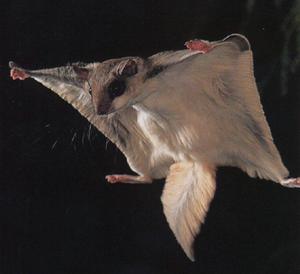
Southern flying squirrels range from the northeast of the United States south to Florida. In the west, they can be found from Minnesota to Texas. One species lives in the San Bernardino Mountains of southern California. Compared to the patchy range of the northern flying squirrel, the range of the southern flying squirrel is more cohesive.
It can be difficult to tell northern and southern flying squirrels apart because they are similar in size and coloring. The northern flying squirrel is slightly smaller, weighing about five ounces. Both are gray and light brown in color, although the northern flying squirrel has a white belly. Their ranges overlap, but one clue to identification is, where do flying squirrels live? The northern flying squirrel generally prefers higher elevations with mostly coniferous — or cone-bearing — trees such as fir, spruce and cedar. The southern flying squirrel is more likely to be found in forests of deciduous trees — those that lose their leaves in the fall. A good way to decide which type of flying squirrel is living in a particular place is to look at the trees.
Another question to answer when identifying flying squirrels is, when are they active? Northern flying squirrels are more tolerant of cold and are active in the winter. Southern flying squirrels are more likely to hole up in their nests and sleep through some of the coldest days, although neither species hibernates for the entire season. Winter snow is no problem for either northern or southern flying squirrels. They glide over the drifts or tunnel under the snow, which shields them from prowling predators.
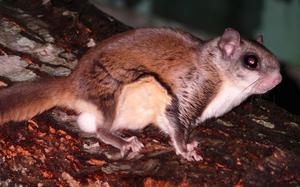
Both northern and southern flying squirrels prefer old-growth forests because they need tall trees with thick cover for protection from the animals that hunt them. Many animals feed on flying squirrels, including foxes and raccoon, birds of prey such as owls and hawks, and even house cats. The small rodents escape from those fierce hunters by gliding from tree to tree and hiding among the twigs and leaves.
Another reason why the question where do flying squirrels live is important is that the squirrels nest in fallen trees but not thin, scrubby ones. They look for snags — dead trees that remain standing — with wide-diameter trunks, that is, older trees, and they seek out nooks and crevices in the decaying wood. They will make use of old woodpecker holes if they find them. They line their nest-holes with shredded moss, leaves and lichen. Sometimes they will build shaggy-looking nests high in trees where two branches join. They will come to human-built nesting boxes, but only if the boxes are in the forested habitat they prefer. They will also take seeds and suet from backyard bird feeders that are within their range.
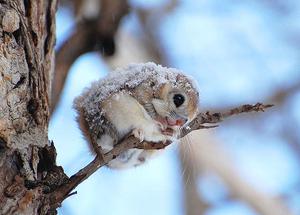
Siberian Flying Squirrel
As the name suggests, this species of flying squirrel lives in a swath of northern Europe and Asia from the Baltic Sea to the Pacific. Its range extends through Russia, Mongolia and northwest China and includes the Korean Peninsula. Siberian flying squirrels also occur on two Pacific islands belonging to Russia and Japan.
In Europe, it is found only in Finland, Estonia and Latvia, where it is considered to be threatened with extinction. It is believed that habitat destruction is causing Siberian flying squirrels to die off. Development cuts forests into parcels that are too small for flying squirrels. Although good at gliding, they cannot cross distances greater than about 150 feet, so barriers such as houses and highways reduce their habitable range. Clear-cutting by loggers also creates clearings that are too expansive for Siberian flying squirrels to get across.
Like their North American relatives, Siberian flying squirrels are nocturnal creatures with large eyes to help them see in the dark. That plus their small size — they weigh about five ounces — makes them hard to observe. It’s possible for people to be living near Siberian flying squirrel populations without ever knowing it.
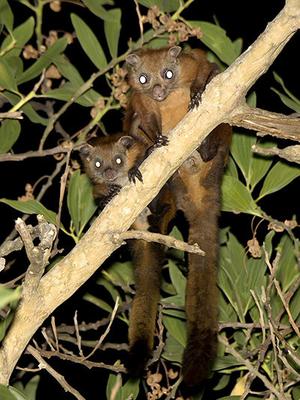
Flying Squirrels of the Rain Forests
Rain forest flying squirrels live only in Southeast Asia, India and Sri Lanka, where the tropical climate is hot and moist and trees grow tall. Flying squirrels glide through the high, dense canopy of the rain forest and are rarely seen because of the height and their nocturnal habits.
The red giant flying squirrel is one of the largest species of flying squirrels, weighing up to five pounds. It ranges from northern India and Nepal to southern China, Myanmar, Thailand and the Malaysian peninsula. It can be found in Sumatra and Borneo. Once found in Singapore, it may now be locally extinct because it has not been sighted there since 1986. One of more than 30 species living in this region, the red giant flying squirrel is unlike its smaller relatives because it can inhabit thinner-growth forests with places clear of trees. Reportedly, the squirrel can glide for distances up to 320 feet.
Two other important species of Southeast Asia are the large black flying squirrel and the red-cheeked flying squirrel. These species range from southern Thailand and peninsular Malaysia to Sumatra and parts of northern Borneo.
Another large species is the Chinese giant flying squirrel. It lives in the mountains of southern China and is sometimes seen in Laos. Its habitat is the spruce forest of high-elevation areas, where it feeds on shoots, leaves and pine nuts.
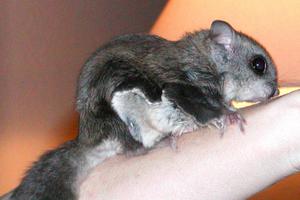
Endangered Flying Squirrels
Some flying squirrels inhabit tiny, specialized locations where they can forage for their favorite foods. One species is the San Bernardino flying squirrel, once found throughout the San Jacinto Mountains of California but now confined to a small section. Its decline is thought to be the result of drought and a warming climate. The San Bernardino flying squirrel’s most important food is a truffle fungus that requires cool, moist conditions to grow. As the mountain forests have become warmer and drier, the truffles have died off and the squirrels have moved into smaller and smaller areas. They are now only found in the higher elevations of the San Bernardino Mountains.
Another species with a small range is the Virginia northern flying squirrel. Its habitat is the red spruce forest of West Virginia, which lies entirely in the Appalachian Mountains. Destruction of the red spruce is believed to have caused the Virginia northern flying squirrel to decrease in number. Red spruce trees were harvested to produce paper products, fine musical instruments and ships. The Virginia northern flying squirrel was listed as endangered when its population dropped to about ten animals, but conservation efforts have increased that number greatly in recent years. Most important have been restoration of the red spruce forest and placement of nest boxes in public areas. Greater awareness by people living in its four-county range has helped the Virginia northern flying squirrel to thrive. People have learned the importance of controlling pets that prey on the flying squirrels and have gained more understanding of how to conserve its habitat.
The Carolina northern flying squirrel became an endangered species as the result of the construction of a highway that sliced through its living space. The Cherohala Skyway is a 40-mile scenic highway that links the western corner of North Carolina to Tennessee, but it is an impassable barrier to the Carolina flying squirrels that live in the mountains of the region. The highway created two stranded populations on opposite sides of the road, resulting in loss of genetic diversity that threatened the survival of the rare species. It was listed as endangered in 1985, but since then, measures have been taken to help the flying squirrels cross the road. Conservationists built 47-foot poles with beams that extend over the highway, shortening the glide distance for the squirrels. Workers also created crevices and holes in the poles, giving the squirrels places to hide from birds of prey.
Since then, wildlife officials have seen flying squirrels’ dens on both sides of the highway.
African Flying Squirrels
An unusual group of flying squirrels lives in western central Africa, including the countries of Cameroon, Central African Republic, Congo, Equatorial Guinea and Uganda. The pygmy scaly-tailed flying squirrel is the smallest of seven different species. It weighs only half an ounce. African flying squirrels inhabit dense tropical forests; fruit is an important food source. Some species are believed to live in colonies of up to 100 members, but the habits of African flying squirrels have not been closely studied.
Featured Articles
-

The Top 4 Bird Feeder Pole Designs
Reviewing the best squirrel proof bird feeder pole designs with tips on how to care for and improve them.
-

A Review of Squirrel Feeders
Want to know the best way for feeding squirrels? Check out these reviews of some of the best squirrel feeders on the market.
-

Squirrel Proof Bird Feeder
So you love the sound of a wood thrush as it sings its songs? Want to attract more of them, but are frustrated by the squirrels that seem to always find a way into the birdseed? Well, check out these squirrel proof bird feeders and enjoy the songbirds to your hearts content.
Recent Articles
-

Where Do Squirrels Live?
Ever see a squirrel and wonder "Where do squirrels live?" Read this article to find out where you can squirrels and their natural habitat.
-

The Top 4 Bird Feeder Pole Designs
Reviewing the best squirrel proof bird feeder pole designs with tips on how to care for and improve them.
-

When do squirrels have babies?
When is the squirrel breeding season? When do squirrels have babies? How long is the squirrel gestation period?
All Articles
-

What Do Ground Squirrels Eat?
Ever see a squirrel and wonder What Do Ground Squirrels eat? Well, the answer may surprise you as they eat just about anything, check out this article for info
-

Do Squirrels Carry Rabies?
Can you answer the question: Do squirrels carry rabies? Squirrels are one of the most common creatures you are likely to run across, read this to find out
-

Squirrel Proof Bird Feeder
So you love the sound of a wood thrush as it sings its songs? Want to attract more of them, but are frustrated by the squirrels that seem to always find a way into the birdseed? Well, check out these squirrel proof bird feeders and enjoy the songbirds to your hearts content.
-

Do Squirrels Hibernate?
Read about some of the studies that have been done to try to answer the question: Do Squirrels Hibernate? It isn't as simple as yes/no!
-

Where Do Flying Squirrels Live?
You have heard of them, and maybe even saw one at the zoo... But have you ever wondered - Where do flying squirrels live? Click here to find out!
-

A Review of Squirrel Feeders
Want to know the best way for feeding squirrels? Check out these reviews of some of the best squirrel feeders on the market.
-

How to take care of a baby squirrel
Read how to take care of a baby squirrel. Information you may need if you ever happen across a nest without a mother.
-

Where Do Squirrels Sleep?
Have you ever wondered "Where Do Squirrels Sleep"? Check out this article to learn the differences between a den and dray as well as if squirrels make nests
-

Can You Have a Pet Squirrel?
Can squirrels be pets? Can they be domesticated? Does a squirrel make a good pet? This article explores the topic of pet squirrels!
-

Do Squirrels Bite?
With so many of these little guys all around, you may be wondering - Do Squirrels Bite? Click here to get the answer as well as some very interesting facts.
-

How to Care for a Baby Squirrel
Learn how to take care of a baby squirrel from birth to 12 weeks old, including methods for reuniting it with its mother
-

When do squirrels have babies?
When is the squirrel breeding season? When do squirrels have babies? How long is the squirrel gestation period?
-

The Top 4 Bird Feeder Pole Designs
Reviewing the best squirrel proof bird feeder pole designs with tips on how to care for and improve them.
-

Where Do Squirrels Live?
Ever see a squirrel and wonder "Where do squirrels live?" Read this article to find out where you can squirrels and their natural habitat.